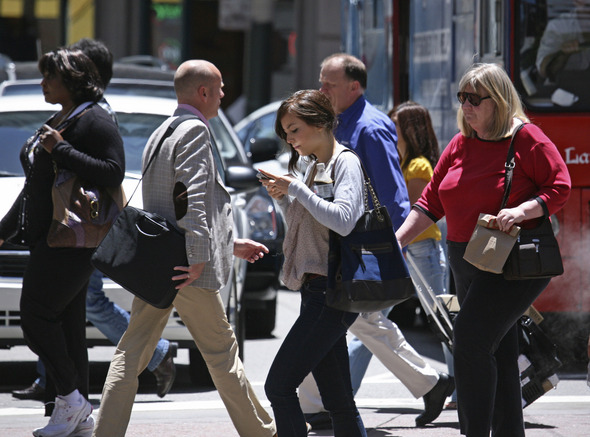'Texting while walking' next distraction to require tech solution, experts say

A woman text messages while walking across the street in San Francisco. While using a cell phone while driving has triggered the most alarm bells and prompted laws in several states, experts say pedestrians are also suffering the consequences of mobile distraction tripping on curbs, walking into traffic, even stepping into manholes as they chat or type while walking.
Associated Press
But he's seen the consequences of paying more attention to the gadget than what's ahead.
"I saw someone walk right into a sign," recalled the 32-year-old Silicon Valley resident. "She didn't hurt herself but she was startled. She dropped her phone, then her friends starting laughing at her. It was funny but I guess it could've been more serious."
While using a cell phone while driving has triggered the most alarm bells and prompted laws in several states, experts say, pedestrians are also suffering the consequences of mobile distraction — tripping on curbs, walking into traffic, even stepping into manholes as they chat or type while walking.
To help these sidewalk stumblers step out more safely, technology companies are now stepping in, creating applications that do everything from make a smartphone screen transparent to transform speech into text.
Whether the technologies will prevent injuries and embarrassment remains to be seen, they are being welcomed as a move in the right direction.
"I don't think we're going to eliminate people from walking into things outright and of course we want people to be responsible, but what we're trying to do is eliminate the friction point ... and give the user back a little mental bandwith," said Travis Bogard, the executive director for product management and strategy at San Francisco-based Aliph, which makes bluetooth earpieces.
Aliph's Jawbone earpiece incorporates voice-to-text technology which eliminates the need to glance down at the keypad to send an e-mail or text message. It also has caller ID that speaks to the wearer so he or she doesn't have to pick up the phone to see who is calling and a function that allows wearers to call up their contacts using their voice rather than fingers.
"All of this gets rid of the need to touch your phone, which causes your eyes to move away from what's in front of you," Bogard said.
Other programs also on the market aim to make it easier to type while walking. They tap into a smartphone's camera to beam an image of what's in front of the user over the message screen so typers can see what's ahead. They include Text Vision, Type n Walk and Email 'n Walk.
"See-through screens, yes, would solve part of the problem," said Clifford Nass, a professor of communications at Stanford University and one of the authors of a study on multitasking. "But there's still a second problem, which has to do with engagement of the brain."
Same goes with voice-to-text technology, Nass said.
"It can help a little bit but the fundamental problem is that we're stuck with brains that can't do all that much when we're doing other things," he said.
Two years ago, the American College of Emergency Physicians issued an alert warning of the dangers of text messaging while walking, driving, biking and in-line skating based on anecdotal evidence from physicians.
Manhattan physician Mark Melrose said he's seen his share of near-misses on the city's busy sidewalks and heard of bad accidents.
"A personal friend almost walked right into a manhole while looking at her phone," he said. "Another friend was actually run over by a bike messenger. She wasn't paying attention, walked into the street and the bike messenger walloped her."
An Ohio State University analysis found that for the past few years, the number of emergency room visits resulting from pedestrian cell phone accidents has doubled year-on-year. The study showed that in 2008, just over 1,000 pedestrians visited emergency rooms for injuries like walking into a pole while texting or spraining an ankle after falling down while talking on a cell phone.
Jack Nasar, a professor of city and regional planning who supervised the study by his graduate student, Derek Troyer, said there were likely even more accidents that were never reported because people won't admit that's how they were injured or the injuries didn't warrant a hospital visit.
"The bottom line is that you're phased out, less aware when you're looking at a phone," he said.
Peter Loeb, an economist at Rutgers University who studied the effect of cell phones on pedestrian fatalities, said cell phones can actually keep people safer because they get ambulances to the scene faster.
But, his study also concluded that once a certain number of phones exist in the market, the benefit disappears.
"As more and more people use cell phones, the distraction effect is overwhelming," Loeb said.
Exacerbating that is texting, which has grown exponentially in recent years. The wireless industry association CTIA reported that the number of text messages sent by its members' customers increased from 32.6 billion in the first six months of 2005 to 740 billion in the first six months of 2009.
At least two states, New York and Illinois, have considered laws limiting the use of personal electronic devices by pedestrians but no bills have been passed.
Most lawmakers and experts agree that Big Brothering the sidewalks is impractical. They instead encourage public outreach and see promise in the technological innovations, including ones that don't involve phones themselves, such as special crosswalk lights to grab walkers' attention better.
"For pedestrians, it's primarily themselves that they put at risk, not others, so that does separate this from driving," said state Sen. Joe Simitian of Palo Alto, who sponsored California's hands-free driving law. "At some point, however, we do have to accept personal responsibility."

